 The Painter and the Buyer, is believed to be a self-portrait by Pieter Bruegel the Elder
The Painter and the Buyer, is believed to be a self-portrait by Pieter Bruegel the Elder
Who was Pieter Brueghel the Elder?
The information provided by historians is not complete or even clear. It is therefore not known with certainty where he was born, but it was probably in Brabant around 1525 - 1530. In 1550 and 1551 Brueghel and Pieter Balten (c. 1525-1588) worked together on an altarpiece for the Guild of glovemakers from Mechelen.
In 1553 we find him in Rome, where he seems to have known the Croatian miniature painter Giulio Clovio. Ten years later, he married in Brussels the daughter of Pieter Coecke Van Aelst, Mayken. From this marriage he had two sons: Pieter (1564-1638), who is known as Hell's Brueghel, and Jan (Jan Bruegel). Nicolas Jonghelinck, a merchant, pledges a collection of paintings to the city of Antwerp. These paintings include sixteen pieces by Bruegel. The church where Bruegel was married, Notre-Dame de la Chapelle in Brussels, has an inscription which indicates that he died on September 9, 1569. The dates appearing on his drawings and engravings tell us about his travels in Italy , but until further notice, the main source is the chapter devoted to him by Carel Van Mander in his Schilder-Boeck (Painters' Book), which appeared in Haarlem in 1604. The biography in question was written about thirty years after Brueghel's death. It is said that Brueghel learned to be an artist from Pieter Coecke Van Aelst, whose daughter he was to marry.
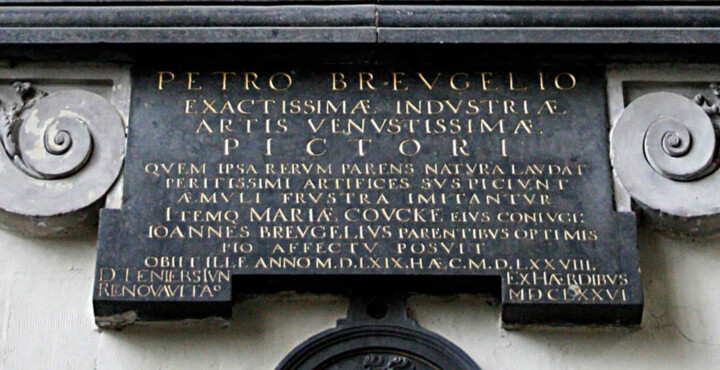 Epitaph of Pieter Bruegel the Elder in the Chapelle church in Brussels (Belgium) © Michel wal
Epitaph of Pieter Bruegel the Elder in the Chapelle church in Brussels (Belgium) © Michel wal
Based in Antwerp, he worked a lot for a certain Hans Franckert, a friend with whom he liked to talk to people at weddings in the countryside to learn how the peasants behaved. Van Mander asserts that Brueghel lived in Antwerp with a servant whom he would certainly have married if she had not had the bad habit of lying. Like all historians, Van Mander likes to talk about others. His future mother-in-law told him he had to move to Brussels to escape his situation in Antwerp. Van Mander also speaks of a number of works, and many of them have been found. Referring to the drawings that Brueghel still had in his boxes, he says: "When he felt that his death was near, he had them burned by his wife." The captions were "either too rude or too funny", so "he was afraid his wife was in trouble".
Brueghel always put his name and the date on his works. So there are not many paints whose names are unclear. It is a miracle that he painted about forty masterpieces in the last ten years of his life. In 1565 he produced the Trebuchet, Christ and the Adulteress, the Massacre of the Innocents and a series of six panels titled Seasons or Months (one of which seems to have disappeared). Brueghel was actually a draughtsman before becoming a painter. His first works are landscapes made during a trip to Italy. Critics said they show a "cosmic" view of the world. Beekeepers and Summer, which are his last works, were produced in 1568.
Bruegel's painting
Most of the time, Brueghel's paintings are presented in three stages:
- the early plays, which were full of real characters;
- the cycle of months, which shows how the world moved according to the laws of nature;
- the last paintings in which a few large figures stand out against a landscape which is only a background.
The painter broke both with his predecessors and with the taste of Italy in the 1600s. By bridging the gap between the Middle Ages and the Renaissance, he went beyond the art of the Flemish Primitives and stood out from the art of the Italians. . The unity of his compositions, his ability to tell stories and his interest in "minor genres" make him an unclassifiable artist in the history of art.
Some historians have attempted to find a connection between Hieronymus Bosch and Bruegel, as they both used figures in their art. Bosch marks the end of the Middle Ages because he is the last "primitive". Bruegel, meanwhile, marks the beginning of a new century, a modern era where we are just beginning to discover man and the world. Bruegel's work, moreover, has nothing to do with religious fear, whereas Bosch's is completely impregnated with it. For one, the world is only a "dream of God" or a trick of the devil; nature is a dangerous temptation. For the other, the acts of man take on their full value: whether they are a source of joy or a test of fate, man must attempt the adventure despite the risks.
Bruegel did not paint naked people as Renaissance artists did, nor was he interested in portraits. The way he looks has nothing to do with the idea that well-rounded bodies are beautiful. In his paintings, which relate essentially to everyday life, the painter shows peasants doing what they do and having fun. For the first time in the history of painting, the rural class is depicted in an objective way that makes them look like real people. The heads are aligned, and you can feel the artist is aware of how people are feeling and their weak points.
When the Council of Trent ended, it was a time of change and great change for the Catholic world. The sacred texts have been translated into common language so that everyone can understand them. Such a change will have many effects. In Holland, it will force painters to show religious scenes in the same simple, easy-to-read way that texts can now be read. For this reason, Bruegel made paintings where the simple drawings of the figures (as in his painting "The Count of Bethlehem") emphasize the ability of the canvas to explain and show things, rather than the skills of the painter as a draughtsman. In his search for the happy medium between dream and reality, he draws most of his ideas from the peasant world. His paintings are based on the daily life of the peasant world, work, madness, popular wisdom and proverbs.
Even Bruegel's biblical scenes are most often set in a village, and the description of the crowded public square is more important than the theme. In the 1600s, the street and the square were places where people could meet and have fun. Winter games, carnival, processions and fairs, dances and country rites were all reasons to celebrate, and the painter knew how to show these gatherings, which Philip II wanted to put an end to. In the Months series, which shows how all living beings are intertwined and how they follow natural cycles, the Stoic idea that the world is a well-built structure in which man has his place and accepts his destiny is demonstrated.
We know that he made about fifty paintings, twelve of which are kept in the Kunsthistorisches Museum in Vienna. Many of his paintings have been lost, and some of those believed to be his were actually copies made by his sons or other artists.
Brueghel's drawings
 Pieter Brueghel the Elder, Summer , 1568, (22 × 28.6 cm ) Hamburg
Pieter Brueghel the Elder, Summer , 1568, (22 × 28.6 cm ) Hamburg
Ludwig Münz compiled a list of all of Brueghel's drawings, which has 150 copies. It includes 77 sketches which are neither dated nor signed (with the exception of a few false signatures), but which almost all bear the words "taken (or drawn) from life" (naar het leven).
At the beginning of the 21st century, there are not many drawings by Bruegel the Elder left. This is due to the fact that many of them have been reassigned to other artists. To find out, just look at the watermarks and monograms on the paper, which show that the designs were made later.
The most recent catalog raisonné of drawings by Pieter Bruegel the Elder lists 61 drawings by the artist himself and six copies. Of these 67 drawings, 35 are made with the intention of being turned into prints. There were 84 engravings published, not counting those made after the painting was executed or after the artist's death. This means that at least 49 drawings are missing.
Brueghel's engravings
The expert Louis Lebeer claims that the number of engravings by Brueghel the Elder is close to a hundred. The name of Brueghel is linked to that of the publisher Jérôme Cock from 1556. The latter drew boards like "The big fish eats the little fish" which were intended to be funny. The Seven Deadly Sins appeared the following year, and the Seven Virtues the following year.
The Wild Rabbit Hunt, which was made in 1560, is the only engraving that Brueghel the Elder will make himself and that Jérôme Cock will publish. The drawing of the beginning is known. Long considered a copy, today it is believed to be the original. He might be a good example of the old saying "running two hares at once". The light effects and the atmosphere of the painting prefigure the two large paintings Hunters in the Snow and The Return of the Herd, where the day and the season play a major role.
Brueghel also made many etchings which were made by other artists and sold by Jérôme Cock. In 1563, Pieter van Der Heyden engraved The Skinny Kitchen and The Fat Kitchen. After his death, his works were again transformed into engravings, just like those of Hieronymus Bosch.
Messages and enigmas of his work
Looking at his paintings and engravings, people thought they saw allusions, rants, even violent protests against the power in place. People thought he cared about the poor and the Reformation. Some think he doesn't take religion very seriously. Others think he knew a lot about alchemy and that his works, like the Dulle Griet, are full of hermetic philosophy. Still others look at the social message that emerges from certain boards and claim that Bruegel was on the side of the poor against the rich.
Brueghel had no doubt that the people were abused and used. He saw that this huge group was controlled by henchmen, called lansquenets, who were chosen from among the worst people. He saw that these mercenaries were also poor devils who could neither read nor write. They were brutes who had to earn a living, even if it meant killing. But there is no evidence that the Massacre of the Innocents panel was intended to give a bad image of the harsh treatment inflicted by the Spanish occupiers. Could the painter have sought to conceal the teasing and accusations by placing them in scenes from the Bible? Modern critical thought tends to mock Brueghel, whose actions are said to be those of a very devious person. But if one admits that his work was full of political references, one would have to think that only a very few people understood them. There is no doubt that Brueghel sometimes makes jokes with hidden meanings, but many of his themes, which were once clear to us, are now difficult to understand. What does this strange confabulation of beggars or cul-de-jatte (1568, Louvre) really mean? Reading the chronicles, we discover, for example, that the fox's tail was a symbol with more than one meaning.
If Bosch's art is deeply rooted in his region, that of Brueghel is also strongly influenced by the same spiritual climate, the Brabant character. The study of Brabant literature and folklore shows that the mysterious Dulle Griet is not always a symbol of war or uprising against the Spanish government. "Dulle Griet" was a common way for people to refer to the shrew, or the woman who acts like a man.
List of works by Brueghel
Landscape with Christ and the Apostles by the Sea of Tiberias, 1553, probably with Maarten de Vos, private collection
Parable of the Sower, 1557, Timken Museum of Art, San Diego (USA)

Oil on wood, 70 × 102 cm.
The sower scatters seeds at random, but only those that land on good soil grow and produce (Gospel of Matthew). For Christians, this means that God speaks to everyone and it is up to each person to decide whether to listen or not. The title has something to do with religion. In reality, the painting is a beautiful scene that Joachim Patinir invented at the beginning of the century. Jan Brueghel de Velours continued to make this kind of paintings.Twelve proverbs, 1558, Mayer van den Bergh Museum, Antwerp (Belgium)
Landscape with the Fall of Icarus, probably circa 1550s, Royal Museums of Fine Arts of Belgium, Brussels - Note: now believed to be a copy of an authentic lost painting by Brueghel.
The Flemish Proverbs, 1559, Gemäldegalerie, Berlin (Germany)
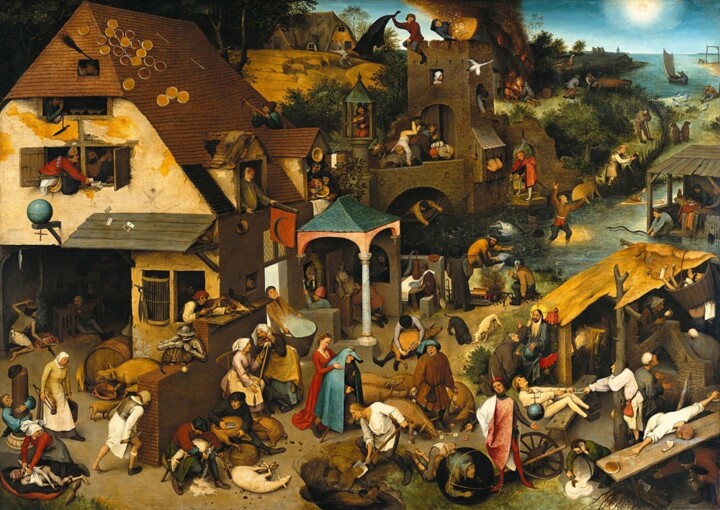
117 x 163 cm, oil on wood.
This painting, also called "The Inverted World" or "The Blue Huque", is one of the first times the artist gave free rein to his half-ironic, half-poetic vision of the world around him. It shows many restless little figures in a more or less invented landscape. It is an image of 85 to 118 proverbs which were common at the time and which everyone knew. For example, there is a wheel with a stick in the right foreground. This shows the expression "to put a spoke in the wheels", which is still used today.The struggle between Carnival and Lent, 1559, Kunsthistorisches Museum, Vienna (Austria)
Portrait of an old woman, 1560, Alte Pinakothek, Munich (Germany)
Temperance, 1560
Children's games, 1560, Kunsthistorisches Museum, Vienna (Austria)

Oil on wood, 116 × 161 cm.
Around 250 children play 84 different games in the streets of a Flemish town. On the left, we can see the countryside, which gives more depth to the picture.Naval battle in the Gulf of Naples, 1560, Galleria Doria-Pamphilj, Rome (Italy)
The Fall of the Rebel Angels, 1562, Royal Museums of Fine Arts of Belgium, Brussels
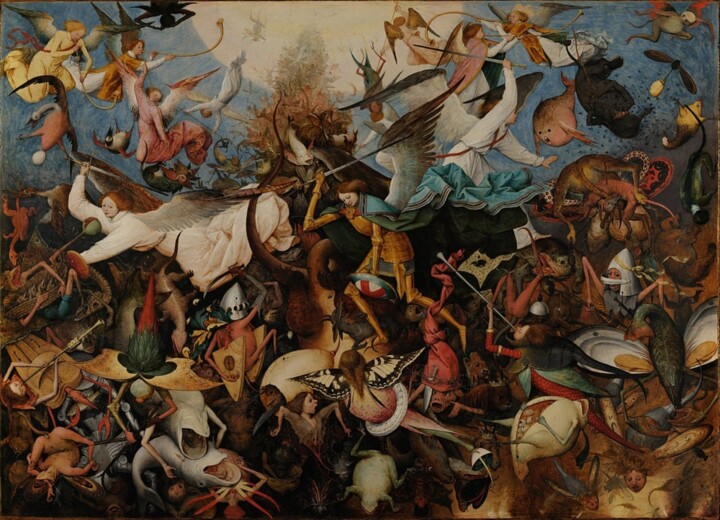
Oil on wood, 117 x 162 cm
This painting is part of a series with many figures, but it is clear that it was Hieronymus Bosch who had the idea: religious themes and an obsession with evil. There are different versions of the Judeo-Christian story of the fall of the rebellious angels, but these are good angels who left God to join the devil (evil). It is because of this betrayal that God brings about their downfall. Here, Saint Michael in armor and his faithful angels (in white) pursue an infinite number of more or less frightening fallen creatures. Compare these monsters to those in Bosch's Garden of Earthly Earthly Inferno (right wing).The Suicide of Saul (Battle against the Philistines on the Gilboa), 1562, Kunsthistorisches Museum, Vienna (Austria)
Two Monkeys, 1562, Staatliche Museen, Gemäldegalerie, Berlin (Germany)
The Triumph of Death, circa 1562, Museo del Prado, Madrid (Spain)

Oil on wood, 117 × 162 cm
A huge post-apocalyptic landscape that is a metaphor for death in its many forms, such as battle, execution, suicide, crime, etc. The Hieronymus Bosch effect is beyond doubt. As with The Fall of the Rebel Angels, what's most interesting today isn't how it looks, but how it shows what people thought at the time. They were religious, but evil and pain were all around them, and it made them feel bad (diseases, wars, etc.).Dulle Griet (Mad Meg), circa 1563, Mayer van den Bergh Museum, Antwerp (Belgium)
The "Great" Tower of Babel, 1563, Kunsthistorisches Museum, Vienna (Austria)
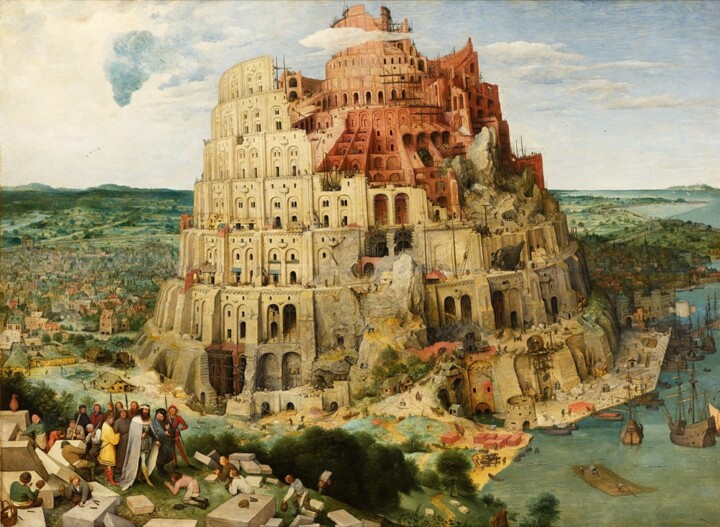
114 x 155 cm, oil on wood
Old Testament. After the flood, the inhabitants of the land of Shinar began to build a very high tower. She was supposed to soar to the sky. God prevents them by making their language difficult to understand so that they cannot speak to each other and by scattering them all over the world. Brueghel's work seems to have been influenced by the Colosseum, which he saw in Rome. On the bottom left we see King Nimrod, who according to the Bible was the first king after the flood.The "little" Tower of Babel, circa 1563, Boijmans Van Beuningen Museum, Rotterdam (Netherlands)
Landscape with the Flight into Egypt, 1563, Courtauld Institute Galleries, London (Great Britain)

37.1 x 55.6 cm, oil on wood
In the style of Patinir, an invented landscape that drags on. It can be compared to Rest on the Flight into Egypt, Patinir's 1520 masterpiece.The Death of the Virgin, 1564, (grisaille), Upton House, Banbury (Great Britain)
The Procession to Calvary, 1564, Kunsthistorisches Museum, Vienna (Austria)

Oil on wood, 124 x 170 cm
Christ carries his cross in the midst of a crowd of people, including Mary, seated in the foreground. The landscape is compound, and a meaningless windmill sits atop a rocky peak. Calvary is in the middle of a circle of small figures in the upper right corner.The Adoration of the Kings, 1564, The National Gallery, London (Great Britain)
Winter landscape with a bird trap, 1565, Royal Museums of Fine Arts of Belgium, Brussels, inv. 8724
The Months, a cycle of probably six paintings of the months or seasons, five of which survive:
- Hunters in the Snow (Dec.-Jan.), 1565, Kunsthistorisches Museum, Vienna (Austria)
117 x 162 cm, oil on wood
This work is one of four paintings that show the changing of the seasons. This is the first time that Brueghel painted a snowy scene. The February page of the Très Riches Heures du Duc de Berry may have given him the idea (1410-1416). But here, the landscape is at the center of attention, whereas in the work of the Limbourg brothers, it was only a secondary note. In the years that followed, Brueghel painted four other paintings on snow.
- The Dark Day (February-March), 1565, Kunsthistorisches Museum, Vienna (Austria) - The Harvest (June-July), 1565, Lobkowicz Palace of the Prague Castle complex, (Czech Republic)
- The Reapers (August-Sept.), 1565, Metropolitan Museum of Art, New York (USA)
- The return of the herd (Oct.-Nov.), 1565, Kunsthistorisches Museum, Vienna (Austria)Christ and the Woman Taken in Adultery (1565), Courtauld Institute of Art, London (Great Britain)
The preaching of John the Baptist, 1566, Budapest Museum of Fine Arts (Hungary)
The census in Bethlehem, 1566, Royal Museums of Fine Arts of Belgium, Brussels
The Wedding Dance, circa 1566, Detroit Institute of Arts, Detroit (USA)
 119.4 x 157.5 cm, oil on wood
119.4 x 157.5 cm, oil on wood
A peasant wedding is depicted vividly and colorfully. Brueghel knew the subject well because he and his friend Hans Franckert had attended such parties.Conversion of Paul, 1567, Kunsthistorishes Museum, Vienna (Austria)
Massacre of the Innocents, c. 1567, versions in the Royal Collection, Kunsthistorisches Museum, Vienna (Austria), Brukenthal National Museum, Sibiu (Republic), and Upton House, Banbury (Great Britain)
The Land of Cockaigne, 1567, Alte Pinakothek, Munich (Germany)
The Adoration of the Magi in the Snow, 1567, Oskar Reinhart Collection, Winterthur (Switzerland)
The Magpie on the Gallows, 1568, Hessisches Landesmuseum, Darmstadt (Germany)
The Misanthrope, 1568, Museo di Capodimonte, Naples (Italy)
The Blind Guiding the Blind, 1568, Museo Nazionale di Capodimonte, Naples (Italy)
The Peasants' Wedding, 1568, Kunsthistorisches Museum, Vienna (Austria)

Oil on wood 114 × 164 cm
This painting goes with the last one to give a complete picture of a peasant wedding in the 1600s. There is a lot of food, and only the bride doesn't eat. The painter's skill as a draftsman can be seen in the way he captured the characters' movements on the spot and in the way he used perspective to make the table seem to go away. The warm colors and soft light make you feel like having fun.The Dance of the Peasants, 1568, Kunsthistorisches Museum, Vienna (Austria)
The beggars (the cripples), 1568, Louvre, Paris (France)
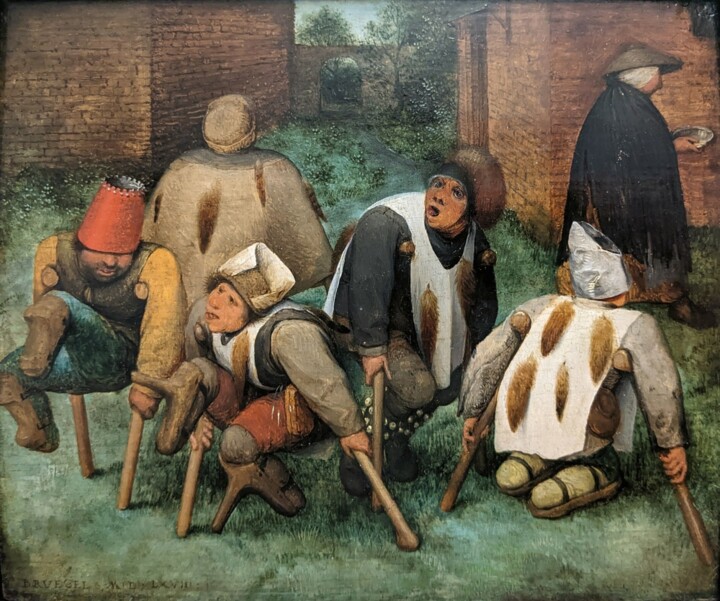
18.5 x 21.5 cm, oil on wood
Five people who cannot walk walk through the sunny courtyard of a red-brick hospital on crutches. Some of them are missing legs. It looks like they're about to split up and go ask different places for money, just like the woman in the background holding out a bowl. On the back of the painting, it is written in Flemish: "Courage, invalids, greetings, may your situation improve." Here again, it seems that Brueghel carefully observed and drew physically handicapped beggars before creating this work, so realistic are the postures and facial expressions.The Peasant and the Nest Thief, 1568, Kunsthistorisches Museum, Vienna (Austria)
The Three Soldiers, 1568, The Frick Collection, New York City (USA)
The Storm at Sea, an unfinished work, probably Brueghel's last painting
The Wine of Saint Martin, Museo del Prado, Madrid (Spain) (discovered in 2010)
Engravings and drawings
The big fish eat the little ones, 1556; we have both Bruegel's drawing and prints after it
Donkey at school, 1556, drawing, Cabinet of Prints, State Museums of Berlin (Germany)
The Calumny of Apelles, 1565, drawing, British Museum, London (Great Britain)
The painter and the connoisseur, drawing, circa 1565, Albertina, Vienna (Austria)
Village Views with Trees and a Mule, 1526-1569, Phoebus Foundation (Netherlands)

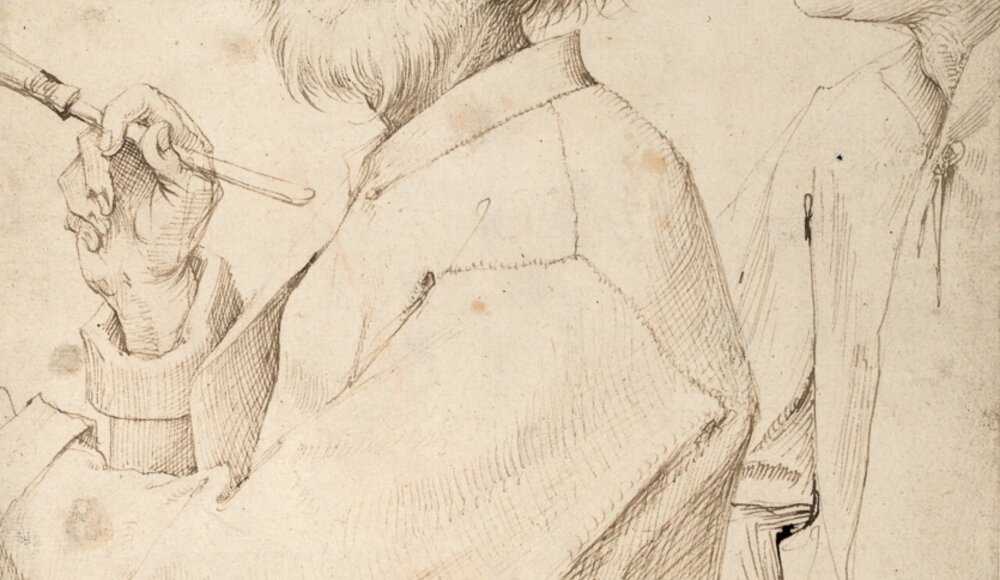
 Selena Mattei
Selena Mattei





